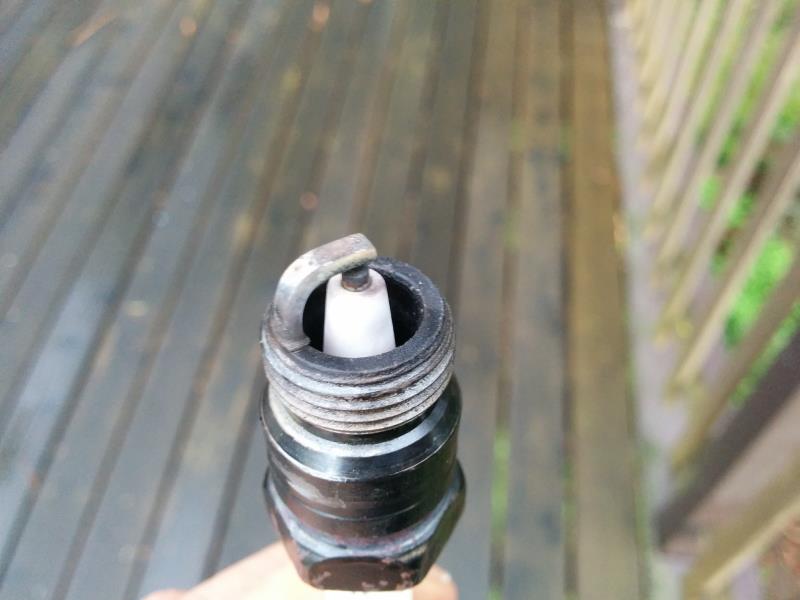|
Group: Forum Members
Last Active: 8 Years Ago
Posts: 41,
Visits: 568
|
Engine is a 292, MSD distributor with 34 degrees total all in at 3,000 rpm with about 8-10 degrees initial. Carb is an Edelbrock 500. The truck runs very well, and behaves flawlessly until WOT when it knocks badly. (92 octane fuel). What do you guys think of this plug? Should I try a richer secondary jet? If I back the initial timing down it just isn't as responsive around town. 
|
|
Group: Administrators
Last Active: 2 days ago
Posts: 7.5K,
Visits: 205.8K
|
The spark plug does not look overly lean assuming it was pulled after some normal driving with no idle time. Have you performed a cranking compression check? Numbers in excess of 150 psi will point to the static compression ratio being on the high side for the fuel you’re using. Any idea what your actual static compression ratio is?
What advance springs are you using in the distributor? What is the advertised intake duration and what lobe centers that the camshaft was ground on? Was the camshaft degreed in when it was installed and if so, what is the intake valve lobe centerline? With some of these numbers, the dynamic compression ratio can be calculated which will give an idea what kind of minimum fuel octane number the engine requires. I'll rule out the carb for the short term as the primary and secondary jets share the same fuel on that particular carb. Had this been a Holley, I would have suggested that the secondary side was not getting fuel. A stopped up secondary carb jet could still be on the list of possibilities. You might check that the power valves are working freely. Another option is to change the metering rods so that the smaller portion of the rod is even smaller thus richening up the mixture only when the manifold vacuum drops below 6" Hg or to the particular PV spring you have installed.
  Lorena, Texas (South of Waco) Lorena, Texas (South of Waco)
|
|
Group: Forum Members
Last Active: 2 Months Ago
Posts: 1.9K,
Visits: 194.9K
|
I'm certainly not disagreeing with Ted, check his items first.
The E 500's I've had tended to be a little lean on the secondary side, both for Y block's and other motors of 327 or 350cid. The springs on the rods are biased towards lower manifold vacuum, and the steps on the rods are a little lean, too. The manual that goes with the carb has excellent tuning info if you take the time to read and absorb it. That took me a while. This is what his final paragraph refers to.
miker
55 bird, 32 cabrio F code
Kent, WA
Tucson, AZ
|
|
Group: Forum Members
Last Active: 8 Years Ago
Posts: 41,
Visits: 568
|
Thanks Ted-
I haven't performed a compression test, but I think I used the ECZ-C heads that were on the previous 272 that was originally in the truck, so even with a few thou off the decks to clean them up when I rebuilt the engine 10 years ago, it shouldn't be too much more than 8.5:1 to maybe 9.0:1 or so. The pistons were not at zero deck, but were close. I'm using steel shim head gaskets. I'm using the blue springs in the distributor. The cam is a Clay Smith that I was told was the same grind as the 245 horse '57 T-bird cam. I installed it straight up if memory serves. I will poke around in the carb on Saturday to rule out a plugged jet. It doesn't knock under low rpm high load, or at mid-throttle high loads. Only at high rpm WOT like when you punch it on the freeway.
|
|
Group: Forum Members
Last Active: 8 Years Ago
Posts: 41,
Visits: 568
|
Miker-
I may need to invest in the calibration kit.
|
|
Group: Forum Members
Last Active: 8 Years Ago
Posts: 41,
Visits: 568
|
So I thought I'd update this thread as I think I've solved the issue. I purchased the 1403 (500 cfm/manual choke) calibration kit. I left the main 0.086 jet alone but went to the next smaller metering rods (063 x 047) replacing the stock 065 x 052 rods. I used the next stage stronger metering rod springs too, going from the stock orange 5' Hg spring to the pink 7" Hg spring. The stronger spring will overcome the vacuum that pulls the rods into the jets a little easier, allowing the rods to lift sooner, effectively enriching the mixture a bit sooner. I also swapped the stock secondary jets from the stock 0.095 to 0.098. I left ignition timing where it was.
The detonation is all but gone. There is a trace of it just as the engine starts to build power at WOT, then seems to dissipate, which indicates to me I'm right where I want to be timing wise. Power seems better too. No signs of the engine running excessively rich either, so I'm going to run it this way then inspect the new plugs I put in there in a few weeks. Hope this helps others using this carb- I think Edelbock sets them up a bit on the lean side out of the box.
Steve
|